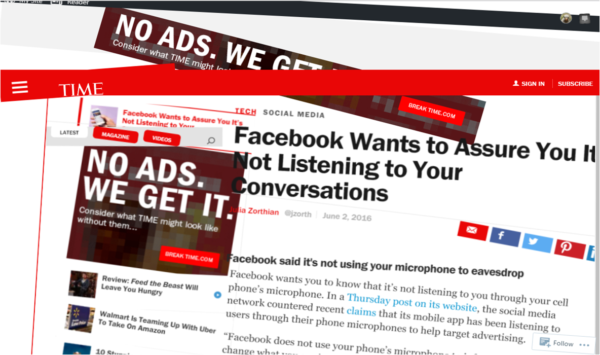
June 9, 2016: Ad blocking, which grew 90 percent in the past 12 months, represents a growing existential threat to the digital publishing ecosystem. Different publishers have been trying a variety of tactics to get ad blocking users to disable them or “whitelist” their sites.
Some publishers, including Forbes, GQ, the Washington Post, employ “ad block walls” that stop users from viewing content unless they disable blockers. Others have resorted to the legal system – both in Germany and in the U.S., most recently with a lawsuit filed with the FTC by the Newspaper Association of America against ad blockers offering “paid whitelisting.” Many others have taken a much gentler tack, imploring users to disable their ad blockers out of respect for the economics powering the open web.
One publisher – Time.com – has taken an innovative, game-like approach to the problem. If you visit this URL with an ad blocker enabled, you’ll be greeted by display ads acknowledging ad blocking’s appeal (“No ads. We get it”) along with an invitation to “Break Time.com” by pressing a button.

Once you press the “Break Time.com” button, the site starts to fall apart, dissolving within your browser window like a collapsing Angry Birds target:
Finally, a message appears notifying the ad blocking user that “Great journalism has value, and it costs money to make it,” along with a request to turn the ad blocker off:

Will the gentle approach work?
Publishers hold their usage data very closely, so it’s impossible to know whether Time’s gentle, entertaining approach has been more effective than those of publishers who’ve taken a harder line against ad blocking users. But it’s interesting to note that Forbes – one of the first publishers to block users from content if they had an ad blocker enabled – appears to have abandoned the hard line approach.
What Time.com has done is interesting because it neither nags or blocks users with ad blockers. Instead, it attempts to entertain them, while simultaneously educating them about why ad blocking isn’t good for journalism. One can imagine other publishers extending this “edutainment-style” approach, perhaps by giving ad blocking users a chance to view a video, infographic, or other interactive element that might inspire them to relent (at least with that particular publisher’s site). Particularly imaginative publishers might even create a scenario (perhaps in VR?) inviting ad blocking users to immerse themselves into the lifeless, content-less desert that will surely result if ad blocking becomes ubiquitous.
While ad blocking remains a massive problem without a clear solution, it’s refreshing to see that publishers are beginning to experiment with anti-ad blocking tactics that go beyond content blocking and user-shaming. With more than $20 billion at stake in the next four years, expect to see more innovation on this front as the ad blocking wars continue to heat up.
- 10 Mistakes to Avoid When Using QR Codes for Marketing - September 20, 2023
- Kevin Lee on How AI Changes the SEO Landscape - August 31, 2023
- The Power of Compound Marketing: Kevin Lee Presents @ 1MediaWorld 2023 Global Conference - March 7, 2023

